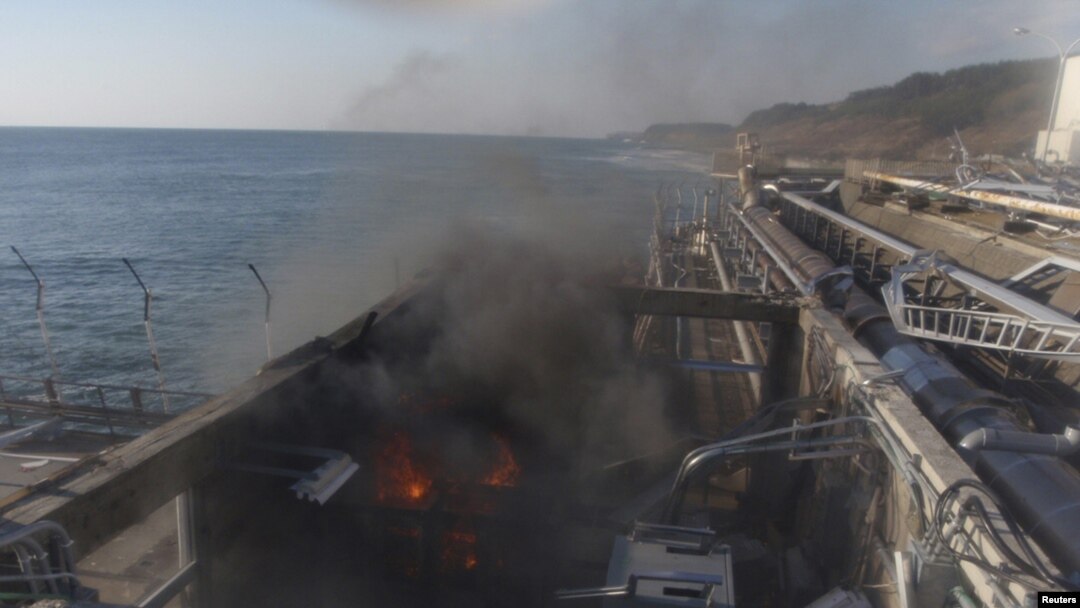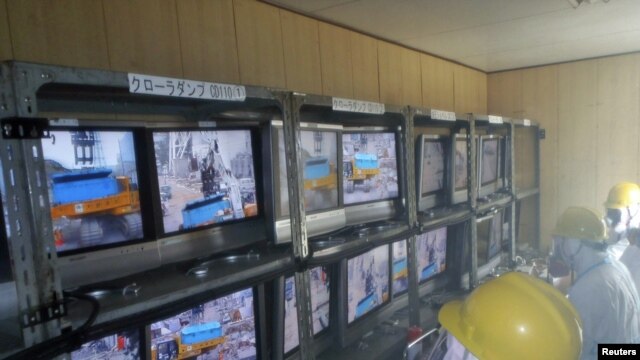Japan today raised the severity of the crisis at its crippled Fukushima Daiichi nuclear power plant to the highest level -- putting it on a par with the world's worst-ever civilian nuclear accident, the 1986 Chornobyl disaster that spread radioactivity across much of Europe.
Japanese nuclear regulators cited cumulative radiation leaks that have contaminated the air, tap water, vegetables, and seawater as the reason for raising the warning level from 5 to 7 -- the highest level on an international scale that is overseen by the International Atomic Energy Agency.
The intensified warning comes after new government assessments of radiation leaks from the Fukushima nuclear power plant that was disabled by the March 11 tsunami.
According to the IAEA, the new ranking signifies a "major accident" that includes widespread effects on the environment and health.
But Hidehiko Nishiyama, a senior official of Japan's nuclear safety agency, is playing down the risk of any health effects so far.
"Based on data we've collected since March 18th, we've given this a preliminary rating of 7," he said. "However, the emission of radioactive substances is about 10 percent of the amount of Chornobyl, which is rated at a similar level."
Prime Minister Naoto Kan has also been emphasizing today that the situation at the plant is slowly improving.
"The nuclear reactor at the Fukushima Daiichi plant is progressing step by step towards stability and the emission of radioactive substances are on the decline," he says.
"I have ordered Tokyo Electric Power Co to come up with an outlook [for bringing the nuclear plant under control] and they should come up with a plan soon."
Nevertheless, the Japanese government is acknowledging that radiation leaks from Fukushima eventually could exceed Chornobyl's emissions if the crisis continues.
Chief cabinet secretary Yuki Edano says the warning reconfirms that Fukushima is "an extremely major disaster."
He also apologized to residents of the area near the nuclear complex and to the international community for "causing such a serious accident."
On April 11, Edano announced that Japan is preparing to expand the 20-kilometer evacuation zone it has set up around Fukushima. Edano said that effort would address concerns about long-term exposure to radiation, as well as the revelation that radioactivity levels further than 20 kilometers from Fukushima are above permissible levels.
"We have made a new decision to expand the evacuation zone," he said. "This is because the radiation in some areas outside the 20-kilometer-radius evacuation zone are higher depending on weather conditions or geographical conditions."
Edano also said that pregnant women, children, and hospital patients should stay at least 30 kilometers away from Fukushima and that schools in the zone would remain closed.
Government plans for an expanded evacuation zone include hot spots that are well beyond the 30-kilometer radius -- including villages to the northwest of Fukushima's reactors where winds have predominantly blown during the past month.
Countries like the United States and Australia had already advised their citizens to stay at least 80 kilometers from Fukushima. But Japan refused to widen the evacuation zone despite earlier calls by the IAEA for it to do so.
The IAEA said on April 10 that its team had measured radiation levels as far as 60 kilometers away that would expose people in just 225 days to the amount of radiation deemed as unsafe in one year of exposure.
Japan's nuclear watchdog says its difficult to say exactly how much radiation has been released. But it is now admitting that radiation leakage has been at least 100 times worse than officials said at the beginning of the crisis.
compiled from agency reports
Japanese nuclear regulators cited cumulative radiation leaks that have contaminated the air, tap water, vegetables, and seawater as the reason for raising the warning level from 5 to 7 -- the highest level on an international scale that is overseen by the International Atomic Energy Agency.
The intensified warning comes after new government assessments of radiation leaks from the Fukushima nuclear power plant that was disabled by the March 11 tsunami.
According to the IAEA, the new ranking signifies a "major accident" that includes widespread effects on the environment and health.
But Hidehiko Nishiyama, a senior official of Japan's nuclear safety agency, is playing down the risk of any health effects so far.
"Based on data we've collected since March 18th, we've given this a preliminary rating of 7," he said. "However, the emission of radioactive substances is about 10 percent of the amount of Chornobyl, which is rated at a similar level."
Workers in protective suits operate remote-controlled machinery to clear debris at the Fukushima nuclear power plant.
Prime Minister Naoto Kan has also been emphasizing today that the situation at the plant is slowly improving.
"The nuclear reactor at the Fukushima Daiichi plant is progressing step by step towards stability and the emission of radioactive substances are on the decline," he says.
"I have ordered Tokyo Electric Power Co to come up with an outlook [for bringing the nuclear plant under control] and they should come up with a plan soon."
Nevertheless, the Japanese government is acknowledging that radiation leaks from Fukushima eventually could exceed Chornobyl's emissions if the crisis continues.
Chief cabinet secretary Yuki Edano says the warning reconfirms that Fukushima is "an extremely major disaster."
He also apologized to residents of the area near the nuclear complex and to the international community for "causing such a serious accident."
On April 11, Edano announced that Japan is preparing to expand the 20-kilometer evacuation zone it has set up around Fukushima. Edano said that effort would address concerns about long-term exposure to radiation, as well as the revelation that radioactivity levels further than 20 kilometers from Fukushima are above permissible levels.
"We have made a new decision to expand the evacuation zone," he said. "This is because the radiation in some areas outside the 20-kilometer-radius evacuation zone are higher depending on weather conditions or geographical conditions."
Edano also said that pregnant women, children, and hospital patients should stay at least 30 kilometers away from Fukushima and that schools in the zone would remain closed.
Government plans for an expanded evacuation zone include hot spots that are well beyond the 30-kilometer radius -- including villages to the northwest of Fukushima's reactors where winds have predominantly blown during the past month.
Countries like the United States and Australia had already advised their citizens to stay at least 80 kilometers from Fukushima. But Japan refused to widen the evacuation zone despite earlier calls by the IAEA for it to do so.
The IAEA said on April 10 that its team had measured radiation levels as far as 60 kilometers away that would expose people in just 225 days to the amount of radiation deemed as unsafe in one year of exposure.
Japan's nuclear watchdog says its difficult to say exactly how much radiation has been released. But it is now admitting that radiation leakage has been at least 100 times worse than officials said at the beginning of the crisis.
compiled from agency reports



